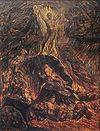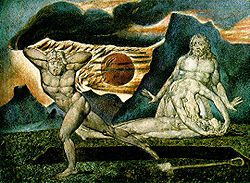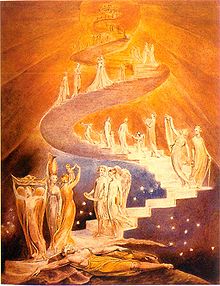
Descriptive Catalogue (1809)
Encyclopedia
The Descriptive Catalogue of 1809 is a description of, and prospectus for, an exhibition by William Blake
of a number of his own illustrations for various topics, but most notably including a set of illustrations to Chaucer's
Canterbury Tales, this last being a response to a collapsed contract with dealer Robert Cromek
.
Having conceived the idea of portraying the characters in Chaucer's Canterbury Pilgrims
, Blake approached Cromek with a view to marketing an engraving. Knowing that Blake was too eccentric to produce a popular work, Cromek promptly commissioned Thomas Stothard
to execute the concept. When Blake learned that he had been cheated, he broke off contact with Stothard, formerly a friend. He also set up an independent exhibition in his brother's haberdashery shop at 27 Broad Street in the Soho
district of London
. The exhibition was designed to market his own version of the Chaucer illustration, along with other works. As a result he wrote his Descriptive Catalogue of 1809, which contains what Anthony Blunt
has called a "brilliant analysis" of Chaucer. It is regularly anthologised as a classic of Chaucer criticism. It also contained detailed explanations of his other paintings.
The price of the Catalogue was 2s 6d (one eighth of a pound sterling), and of admission to the exhibition 1s (one twentieth of a pound sterling); the usual price for exhibitions at the period. At the time a minor house servant might be paid ten pounds per year. An Index to the Catalogue was free with admission to the exhibition.
The Preface to the Catalogue begins with a diatribe against "the Venetian" Correggio
and Titian
. It concludes (using the conventional spellings of his day):
Although now lost, The Ancient Britons was the most sensational of the works displayed and with dimensions of some 10 ft by 14 ft, was the largest work ever executed by Blake. The painting depicted the last battle of King Arthur
against the Romans
.
The exhibition was very poorly attended, with none of the temperas or watercolours sold and was described as "a dead failure". There was ony one review, in The Examiner
, which was hostile.
Between April and October 2009 many of the works displayed at the original exhibition were put on display together once more at Tate Britain
.
William Blake
William Blake was an English poet, painter, and printmaker. Largely unrecognised during his lifetime, Blake is now considered a seminal figure in the history of both the poetry and visual arts of the Romantic Age...
of a number of his own illustrations for various topics, but most notably including a set of illustrations to Chaucer's
Geoffrey Chaucer
Geoffrey Chaucer , known as the Father of English literature, is widely considered the greatest English poet of the Middle Ages and was the first poet to have been buried in Poet's Corner of Westminster Abbey...
Canterbury Tales, this last being a response to a collapsed contract with dealer Robert Cromek
Robert Cromek
Robert Hartley Cromek was an engraver, editor, art dealer and entrepreneur who was most active in the early nineteenth century. He is best known for having allegedly cheated William Blake out of the potential profits of his engraving depicting Chaucer's Canterbury Pilgrims.In the early years of...
.
Having conceived the idea of portraying the characters in Chaucer's Canterbury Pilgrims
The Canterbury Tales
The Canterbury Tales is a collection of stories written in Middle English by Geoffrey Chaucer at the end of the 14th century. The tales are told as part of a story-telling contest by a group of pilgrims as they travel together on a journey from Southwark to the shrine of Saint Thomas Becket at...
, Blake approached Cromek with a view to marketing an engraving. Knowing that Blake was too eccentric to produce a popular work, Cromek promptly commissioned Thomas Stothard
Thomas Stothard
Thomas Stothard was an English painter, illustrator and engraver.-Life and work:Stothard was born in London, the son of a well-to-do innkeeper in Long Acre, London. A delicate child, he was sent at the age of five to a relative in Yorkshire, and attended school at Acomb, and afterwards at...
to execute the concept. When Blake learned that he had been cheated, he broke off contact with Stothard, formerly a friend. He also set up an independent exhibition in his brother's haberdashery shop at 27 Broad Street in the Soho
Soho
Soho is an area of the City of Westminster and part of the West End of London. Long established as an entertainment district, for much of the 20th century Soho had a reputation for sex shops as well as night life and film industry. Since the early 1980s, the area has undergone considerable...
district of London
London
London is the capital city of :England and the :United Kingdom, the largest metropolitan area in the United Kingdom, and the largest urban zone in the European Union by most measures. Located on the River Thames, London has been a major settlement for two millennia, its history going back to its...
. The exhibition was designed to market his own version of the Chaucer illustration, along with other works. As a result he wrote his Descriptive Catalogue of 1809, which contains what Anthony Blunt
Anthony Blunt
Anthony Frederick Blunt , was a British art historian who was exposed as a Soviet spy late in his life.Blunt was Professor of the History of Art at the University of London, director of the Courtauld Institute of Art, Surveyor of the King's Pictures and London...
has called a "brilliant analysis" of Chaucer. It is regularly anthologised as a classic of Chaucer criticism. It also contained detailed explanations of his other paintings.
The price of the Catalogue was 2s 6d (one eighth of a pound sterling), and of admission to the exhibition 1s (one twentieth of a pound sterling); the usual price for exhibitions at the period. At the time a minor house servant might be paid ten pounds per year. An Index to the Catalogue was free with admission to the exhibition.
The Preface to the Catalogue begins with a diatribe against "the Venetian" Correggio
Antonio da Correggio
Antonio Allegri da Correggio , usually known as Correggio, was the foremost painter of the Parma school of the Italian Renaissance, who was responsible for some of the most vigorous and sensuous works of the 16th century...
and Titian
Titian
Tiziano Vecelli or Tiziano Vecellio Tiziano Vecelli or Tiziano Vecellio Tiziano Vecelli or Tiziano Vecellio (c. 1488/1490 – 27 August 1576 better known as Titian was an Italian painter, the most important member of the 16th-century Venetian school. He was born in Pieve di Cadore, near...
. It concludes (using the conventional spellings of his day):
Colouring does not depend on where the Colours are put, but on where the lights and darks are put, and all depends on Form or Outline, on where that is put; where that is wrong, the Colouring never can be right; and it is always wrong in Titian and Correggio, Rubens and Rembrandt. Till we get rid of Titian and Correggio, Rubens and Rembrandt, We never shall equal RafaelRaphaelRaffaello Sanzio da Urbino , better known simply as Raphael, was an Italian painter and architect of the High Renaissance. His work is admired for its clarity of form and ease of composition and for its visual achievement of the Neoplatonic ideal of human grandeur...
and Albert DurerAlbrecht DürerAlbrecht Dürer was a German painter, printmaker, engraver, mathematician, and theorist from Nuremberg. His prints established his reputation across Europe when he was still in his twenties, and he has been conventionally regarded as the greatest artist of the Northern Renaissance ever since...
, Michael AngeloMichelangeloMichelangelo di Lodovico Buonarroti Simoni , commonly known as Michelangelo, was an Italian Renaissance painter, sculptor, architect, poet, and engineer who exerted an unparalleled influence on the development of Western art...
, and Julio RomanoGiulio RomanoGiulio Romano was an Italian painter and architect. A pupil of Raphael, his stylistic deviations from high Renaissance classicism help define the 16th-century style known as Mannerism...
.
Although now lost, The Ancient Britons was the most sensational of the works displayed and with dimensions of some 10 ft by 14 ft, was the largest work ever executed by Blake. The painting depicted the last battle of King Arthur
King Arthur
King Arthur is a legendary British leader of the late 5th and early 6th centuries, who, according to Medieval histories and romances, led the defence of Britain against Saxon invaders in the early 6th century. The details of Arthur's story are mainly composed of folklore and literary invention, and...
against the Romans
Roman Empire
The Roman Empire was the post-Republican period of the ancient Roman civilization, characterised by an autocratic form of government and large territorial holdings in Europe and around the Mediterranean....
.
The exhibition was very poorly attended, with none of the temperas or watercolours sold and was described as "a dead failure". There was ony one review, in The Examiner
Examiner
The Examiner was a weekly paper founded by Leigh and John Hunt in 1808. For the first fifty years it was a leading intellectual journal expounding radical principles, but from 1865 it repeatedly changed hands and political allegiance, resulting in a rapid decline in readership and loss of...
, which was hostile.
Between April and October 2009 many of the works displayed at the original exhibition were put on display together once more at Tate Britain
Tate Britain
Tate Britain is an art gallery situated on Millbank in London, and part of the Tate gallery network in Britain, with Tate Modern, Tate Liverpool and Tate St Ives. It is the oldest gallery in the network, opening in 1897. It houses a substantial collection of the works of J. M. W. Turner.-History:It...
.
Works included
The Index to the Catalogue is as follows:-| Image | Title | Number | Notes |
|---|---|---|---|
| I | The Spiritual form of Nelson Horatio Nelson, 1st Viscount Nelson Horatio Nelson, 1st Viscount Nelson, 1st Duke of Bronté, KB was a flag officer famous for his service in the Royal Navy, particularly during the Napoleonic Wars. He was noted for his inspirational leadership and superb grasp of strategy and unconventional tactics, which resulted in a number of... guiding Leviathan Leviathan Leviathan , is a sea monster referred to in the Bible. In Demonology, Leviathan is one of the seven princes of Hell and its gatekeeper . The word has become synonymous with any large sea monster or creature... |
||
| II | The Spiritual form of Pitt William Pitt the Younger William Pitt the Younger was a British politician of the late 18th and early 19th centuries. He became the youngest Prime Minister in 1783 at the age of 24 . He left office in 1801, but was Prime Minister again from 1804 until his death in 1806... guiding Behemoth Behemoth Behemoth is a mythological beast mentioned in the Book of Job, 40:15-24. Metaphorically, the name has come to be used for any extremely large or powerful entity.-Plural as singular:... |
||
| III | The Canterbury Pilgrims, from Chaucer | Shown is Blake's engraving based on the painting, rather than the painting itself |
|
| IV | The Bard, from Gray Thomas Gray Thomas Gray was a poet, letter-writer, classical scholar and professor at Cambridge University.-Early life and education:... |
||
| Lost | V | The Ancient Britons | |
| VI | A Subject from Shakspeare [sic] | ||
| VII | The Goats | ||
| VIII | The Spiritual Protector | ||
 |
IX | Satan Satan Satan , "the opposer", is the title of various entities, both human and divine, who challenge the faith of humans in the Hebrew Bible... calling up his Legions, from Milton John Milton John Milton was an English poet, polemicist, a scholarly man of letters, and a civil servant for the Commonwealth of England under Oliver Cromwell... |
|
| X | The Bramins Brahmin Brahmin Brahman, Brahma and Brahmin.Brahman, Brahmin and Brahma have different meanings. Brahman refers to the Supreme Self... [sic] - A Drawing |
a depiction of Charles Wilkins Charles Wilkins Sir Charles Wilkins, KH, FRS , was an English typographer and Orientalist, notable as the first translator of Bhagavad Gita into English, and as the creator of the first Devanagari typeface.... consulting Brahmins while making the first English translation of the Bhagavad Gita Bhagavad Gita The ' , also more simply known as Gita, is a 700-verse Hindu scripture that is part of the ancient Sanskrit epic, the Mahabharata, but is frequently treated as a freestanding text, and in particular, as an Upanishad in its own right, one of the several books that constitute general Vedic tradition... . |
|
 |
XI | The Body of Abel found by Adam and Eve Adam and Eve Adam and Eve were, according to the Genesis creation narratives, the first human couple to inhabit Earth, created by YHWH, the God of the ancient Hebrews... , Cain fleeing away - A Drawing |
[] |
| XII | Soldiers casting Lots for Christ's Garment - A Drawing | [] | |
 |
XIII | Jacob's Ladder - A Drawing | [] |
| XIV | Angels hovering over the Body of Jesus in the Sepulchre - A Drawing | [] | |
| XV | Ruth - A Drawing | [] | |
| XVI | The Penance of Jane Shore Jane Shore Elizabeth "Jane" Shore was one of the many mistresses of King Edward IV of England, the first of the three whom he described respectively as "the merriest, the wiliest, and the holiest harlots" in his realm... - A Drawing |
Sources
- ed. Geoffrey KeynesGeoffrey KeynesSir Geoffrey Langdon Keynes was an English biographer, surgeon, physician, scholar and bibliophile...
: "Blake: Complete Writings", Oxford University PressOxford University PressOxford University Press is the largest university press in the world. It is a department of the University of Oxford and is governed by a group of 15 academics appointed by the Vice-Chancellor known as the Delegates of the Press. They are headed by the Secretary to the Delegates, who serves as...
, 1989. ISBN 0-19-281050-2. Based on material originally published by the Nonesuch PressNonesuch PressNonesuch Press was a private press founded in 1922 in London by Francis Meynell, his wife Vera Mendel, and David Garnett.-History:Nonesuch Press's first book, a volume of John Donne's Love Poems was issued in May 1923. In total, the press produced more than 140 books. The press was at its peak in...
, 1948 and 1957, and subsequently transferred to OUP.

